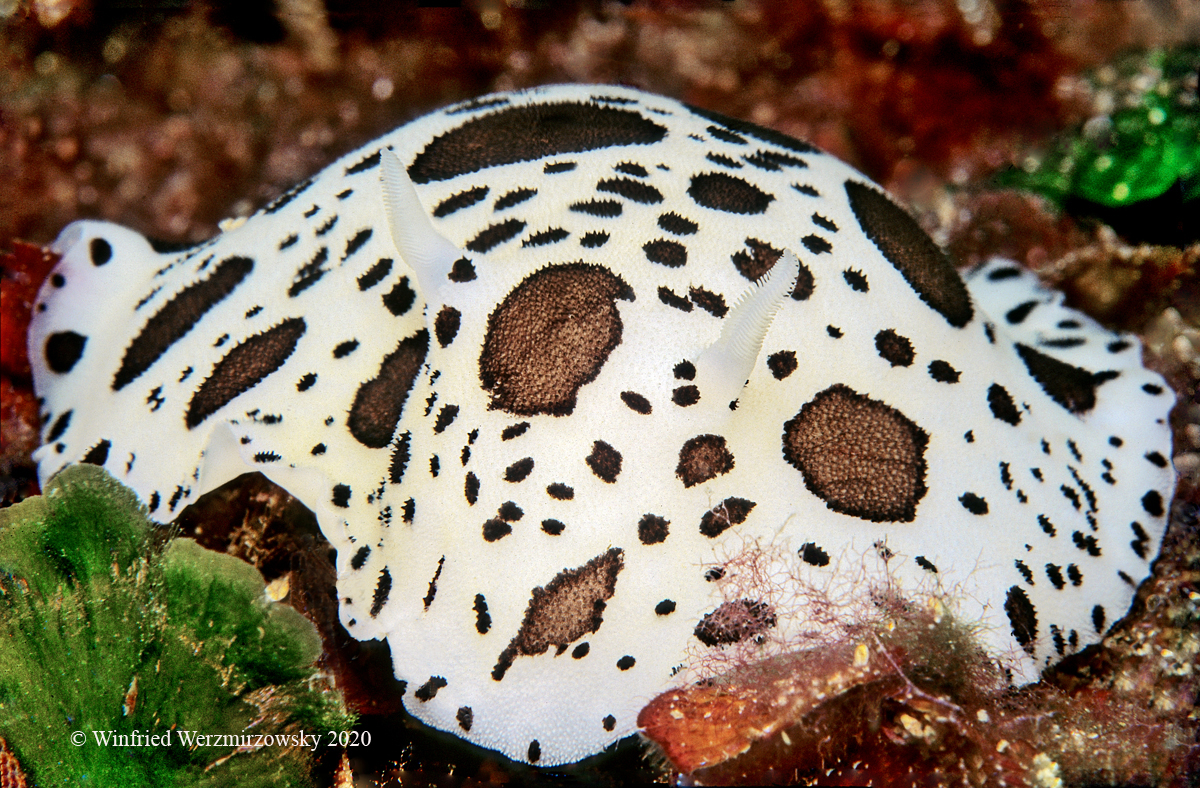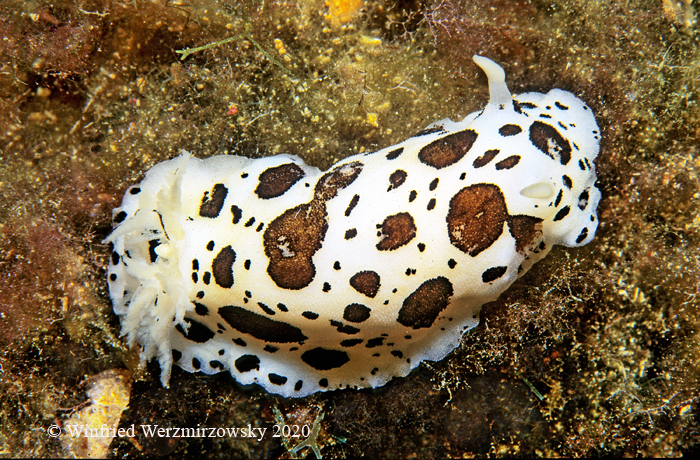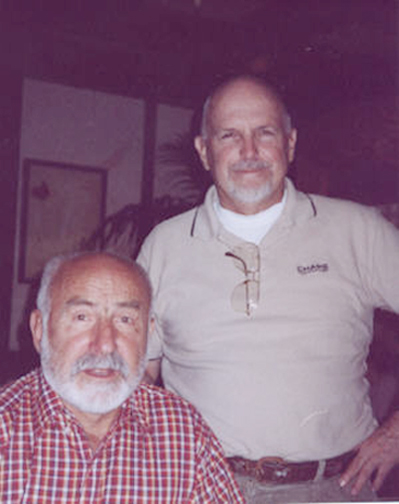 |
Image courtesy of Winfreid Werzmirzowsky
Ibiza (Med)
Nikon RS

Webmaster Mike hasn't featured that many critters from the Mediterranean Sea. I am not sure why, as the Med has some of the most flamboyant aposomatic species known from any of the Earth's oceans. Take Chromodoris luteorosea (von Rapp, 1827)(Courtesy of Bill Rudman's Sea Slug Forum) for example. Holy cow. Peltodoris atromaculata is not exactly aposomatically colored, but what is interesting to me from a global diversity standpoint is that similar colored species (white with dark spots) occur in every ocean around the earth. In the North Pacific it is Diaulula sandiengensis and Diaulula odonoghuei. In the South Pacific we have Jorunna funebris and Diaulula sp. 2 (pg 122 in NSSI 2nd Ed). In the southeastern Atlantic Aldisa trimaculata and in the tropical western Atlantic Aphelodoris antillensis . Please don't ask me why as I have no idea. It is interesting however that there must be some ecological reason that this coloration has been naturally selected for in each region. Maybe it is more aposomatic than I thought. It's like if there is an empty color slot on the pallet - we must fill it. Like its sister species is these other seas, Peltodoris atromaculata is quite variable in color, ranging from almost solid dark blotches, separated by thin white areas to also completely white with a few broken dark spots. Sometime the white is a more straw color. The rhinophores and gill are always white. |
This species is known to feed on the encrusting sponge, Petrosia ficiformis, and is known from the Mediterranean and nearby Atlantic coasts.
Dave Behrens
Sammamish, WA 98074
Dec., 2020
Send Dave email at davidwbehrens@gmail.com
Frankfurt, Germany
April, 2004

Webmaster's Notes: I first met Winfried many years ago back at Dive Paradise, Tulamben, Bali, Indonesia when we had adjoining rooms. Being somewhat in awe of his orderly arrangement of cameras and dive equipment, I was at first hesitant to strike up a conversation of in view of my less than organized gear strewn about my room. Perfect odd couple I though until my buddy Jerry Allen introduced us and I never looked back! Winfried's underwater photographic zeal is best exemplified by an incident on a succeeding trip to Bali. His Nikon RS teleconverter failed and he decided to go back to Germany to have it repaired. What a shame I said, to abort a trip over a part failure! Winfried replied, "who's aborting, I will be back in a few days." Sure enough he reappeared in four days with a repaired teleconverter. At that time there was only two technicians in the world who would work on RS cameras and one of them resided in Germany, so thats where Winfreid headed! Being a retired Lufthansa pilot certainly facilitated his journey, but it still required a lot of fortitude and dedication on his part. So, when invited to visit him in Germany and see his images of Indonesia, I grabbed the wife and we took off to Germany in April of 2004. Who would of though we would fly half way around the world to see underwater images?? Well, it was certainly worth it! Winfried's images have appeared in several publications, the one that presently comes to mind is "Crustacea-Guide of the World" by Helmut Debelius. What more can be said, Winfried is a first rate underwater photographer! The most difficult aspect of getting to know Winfreid for me was pronouncing his last name! I eventually gave up! To me he has always been and will be Winfreid! I count myself very fortunate in this liftime to have made his acquaintance!
Send Winfreid email at Winfried Werzmirzowsky
|

Attention all you Sluggers, and you know who you are! The NSSI 2nd edition is now available in ebook PDF and book form . The hard back version will become available Nov. 1st. Both will cost $65 (individually). You will need to jump through a few hoops to get the electronic version as pdf distribution is protected by Adobe ID!! Please read the following to enable reading your electronic purchase! This new 2nd Edition is updated and reorganized, including 185 new species. Among other features, the new edition includes additional photographs of species, an identification key, and an up-to-date classification reflecting the latest evolutionary relationships. The Indo-Pacific represents the largest expanse of tropical ocean in the world, stretching from the Indian Ocean coast of southern Africa and the Red Sea to the central Pacific of the Hawaiian Islands, Easter Island and the Marquesas. This region supports the most diverse marine fauna of any place in the world for most groups of marine organisms. The nudibranchs and sea slugs are no exception to this rule; there are about 3,000 described species of these organisms in the world and at least 40% of these have been found exclusively in the Indo-Pacific tropics. This book illustrates 2,138 Indo-Pacific nudibranchs and sea slugs, including many undescribed species.
|

|
